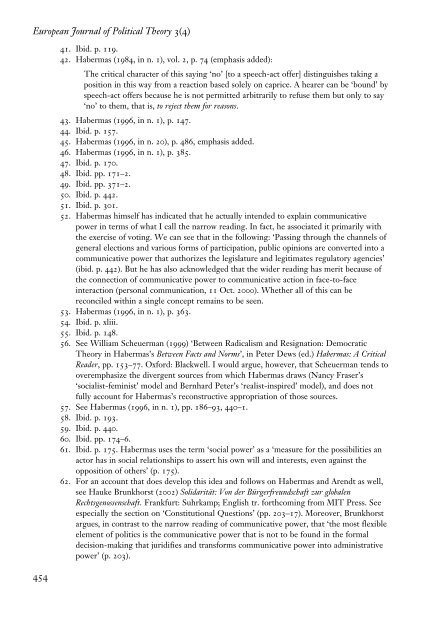Communicative Power in Habermas's Theory of Democracy
Communicative Power in Habermas's Theory of Democracy
Communicative Power in Habermas's Theory of Democracy
Create successful ePaper yourself
Turn your PDF publications into a flip-book with our unique Google optimized e-Paper software.
European Journal <strong>of</strong> Political <strong>Theory</strong> 3(4)45441. Ibid. p. 119.42. Habermas (1984, <strong>in</strong> n. 1), vol. 2, p. 74 (emphasis added):The critical character <strong>of</strong> this say<strong>in</strong>g ‘no’ [to a speech-act <strong>of</strong>fer] dist<strong>in</strong>guishes tak<strong>in</strong>g aposition <strong>in</strong> this way from a reaction based solely on caprice. A hearer can be ‘bound’ byspeech-act <strong>of</strong>fers because he is not permitted arbitrarily to refuse them but only to say‘no’ to them, that is, to reject them for reasons.43. Habermas (1996, <strong>in</strong> n. 1), p. 147.44. Ibid. p. 157.45. Habermas (1996, <strong>in</strong> n. 20), p. 486, emphasis added.46. Habermas (1996, <strong>in</strong> n. 1), p. 385.47. Ibid. p. 170.48. Ibid. pp. 171–2.49. Ibid. pp. 371–2.50. Ibid. p. 442.51. Ibid. p. 301.52. Habermas himself has <strong>in</strong>dicated that he actually <strong>in</strong>tended to expla<strong>in</strong> communicativepower <strong>in</strong> terms <strong>of</strong> what I call the narrow read<strong>in</strong>g. In fact, he associated it primarily withthe exercise <strong>of</strong> vot<strong>in</strong>g. We can see that <strong>in</strong> the follow<strong>in</strong>g: ‘Pass<strong>in</strong>g through the channels <strong>of</strong>general elections and various forms <strong>of</strong> participation, public op<strong>in</strong>ions are converted <strong>in</strong>to acommunicative power that authorizes the legislature and legitimates regulatory agencies’(ibid. p. 442). But he has also acknowledged that the wider read<strong>in</strong>g has merit because <strong>of</strong>the connection <strong>of</strong> communicative power to communicative action <strong>in</strong> face-to-face<strong>in</strong>teraction (personal communication, 11 Oct. 2000). Whether all <strong>of</strong> this can bereconciled with<strong>in</strong> a s<strong>in</strong>gle concept rema<strong>in</strong>s to be seen.53. Habermas (1996, <strong>in</strong> n. 1), p. 363.54. Ibid. p. xliii.55. Ibid. p. 148.56. See William Scheuerman (1999) ‘Between Radicalism and Resignation: Democratic<strong>Theory</strong> <strong>in</strong> Habermas’s Between Facts and Norms’, <strong>in</strong> Peter Dews (ed.) Habermas: A CriticalReader, pp. 153–77. Oxford: Blackwell. I would argue, however, that Scheuerman tends tooveremphasize the divergent sources from which Habermas draws (Nancy Fraser’s‘socialist-fem<strong>in</strong>ist’ model and Bernhard Peter’s ‘realist-<strong>in</strong>spired’ model), and does notfully account for Habermas’s reconstructive appropriation <strong>of</strong> those sources.57. See Habermas (1996, <strong>in</strong> n. 1), pp. 186–93, 440–1.58. Ibid. p. 193.59. Ibid. p. 440.60. Ibid. pp. 174–6.61. Ibid. p. 175. Habermas uses the term ‘social power’ as a ‘measure for the possibilities anactor has <strong>in</strong> social relationships to assert his own will and <strong>in</strong>terests, even aga<strong>in</strong>st theopposition <strong>of</strong> others’ (p. 175).62. For an account that does develop this idea and follows on Habermas and Arendt as well,see Hauke Brunkhorst (2002) Solidarität: Von der Bürgerfreundschaft zur globalenRechtsgenossenschaft. Frankfurt: Suhrkamp; English tr. forthcom<strong>in</strong>g from MIT Press. Seeespecially the section on ‘Constitutional Questions’ (pp. 203–17). Moreover, Brunkhorstargues, <strong>in</strong> contrast to the narrow read<strong>in</strong>g <strong>of</strong> communicative power, that ‘the most flexibleelement <strong>of</strong> politics is the communicative power that is not to be found <strong>in</strong> the formaldecision-mak<strong>in</strong>g that juridifies and transforms communicative power <strong>in</strong>to adm<strong>in</strong>istrativepower’ (p. 203).
















